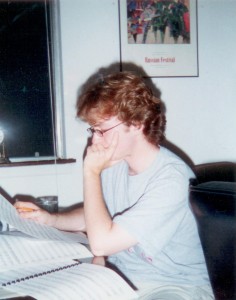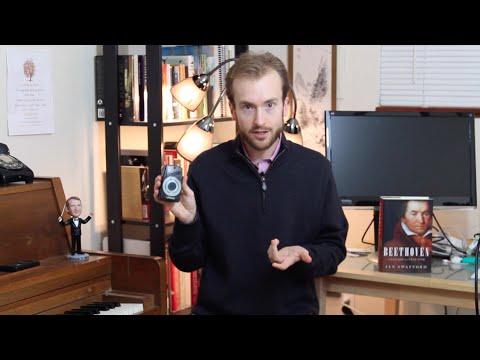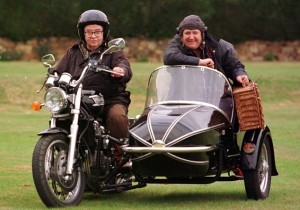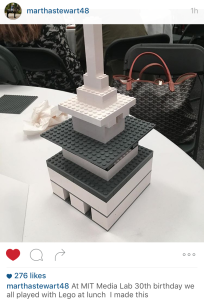
Me composing at age 19, i.e. 13 years ago, i.e. just kill me now.
It recently dawned on me that I have now been composing music for TWENTY YEARS. I wrote my first piece for a 7th grade English assignment on “A Midsummer Night’s Dream”. I was 12 then. I’m 32 now.
I’ll spare you the psychological torment that’s accompanied this realization and instead offer you some advice from my two decades of experience:
Process
- Think carefully about what you want your piece to depict / represent / express. For me, this is probably 75% of my time spent working on a piece.
- Listen to your favorite pieces while reading along with the score. Don’t be afraid to imitate music by the composers you like. Eventually what is theirs will wear away and what is yours will remain. A composer’s language is the assembled residue of his many influences.
- Establish the ‘ground rules’ early on in your piece. What is the basic style / musical language? Is this piece going to be full of surprises? Full of whimsy? Full of solemnity? Give the listener some idea early on.
- Sometimes you’ll start off writing a piece following a certain “concept” (a theoretical approach, a program idea, a mathematical formula) and you’ll get to a part where your gut tells you to break the rules you’ve set up in order to achieve a more satisfying musical moment. Follow that instinct.
- Don’t be afraid to throw out what’s not working. With each passing year, I grow more confident abandoning ideas that I may have been developing for days. The effort you put in will pay off somewhere down the line, and your piece will be much the better; there are always more ideas. That said, sometimes composing is a real slog.
Structure
- Use patterns. If you want to surprise your listener with something odd, striking, or novel, it’s best accomplished by breaking an established pattern. Sudden changes in texture / style / patterning should be the exception, not the rule though.
- Structure your piece so that the main climax comes towards the end of the work. In the classical era, this was often the end of the development / transition into the recapitulation. The climax is often the most dissonant moment. (See the golden ratio.) Consider very carefully the architecture of smaller climaxes leading up to your main one.
- Fill the space. Look at a painting by a great artist or a film by a great director. Visual artists are keenly aware of managing the space in their frame and balancing all the parts. The same thing goes for musical textures. Think of each bar as a frame, a single shot, in your progression. Each beat, or the subdivision of each beat, is an area of the screen. Be very careful to balance the bar so that it is full. (See: Ravel, Dukas “La Peri”.) (But of course, not too full. See: Star Wars “Special Edition”.) The melody is like a character moving through the space.
Melody
- Let every bar of every part ring with melody (see: Brahms, Debussy, et al.)
- In traditional styles, the melody should have a fill at the end of a phrase (sort of a little melodic ‘tag’).
- Very often the best melodies have one apex pitch – a highest (or lowest) pitch that is not repeated. Many composers save this pitch for the end (or towards the end) in order to give the melody a clear shape.
- Melodic patterns that ascend by step are often very memorable (see: Richard Rodgers.) Stepwise patterning also breeds predictability, which gives you the opportunity to break the pattern and deliver a pleasant surprise.
Writing for musicians
- For some reason, Richard Strauss got away with writing outlandishly demanding passages for his musicians and nobody batted an eyelash (well, maybe they did, but now they don’t.) You’re not Richard Strauss. Make your music challenging and interesting and even novel, but achievable.
- Keep in mind that your musicians will be more engaged if they’re not sitting around for too long. That being said, when writing for orchestra or large ensemble, don’t include every instrument in every texture / passage. The orchestra has thousands of possibilities for chamber ensembles.
- Create opportunities in which you are writing for people you know, and write for their particular skills and personalities. This will make your pieces more rewarding for everyone, and will keep your performers coming back for more.
- Think too about the instruments you’ll be writing for. What makes them special / sound their best? What was their historical function? Try to structure your piece in some way around the instruments themselves.
Finally, I’ll just mention that I think the greatest compositional challenge is to write music for a solo instrument, especially an instrument capable of playing only one note at a time. Bach’s sonatas and partitas for the solo violin are about as good as it gets, but strictly speaking, we might say Debussy won this contest:







